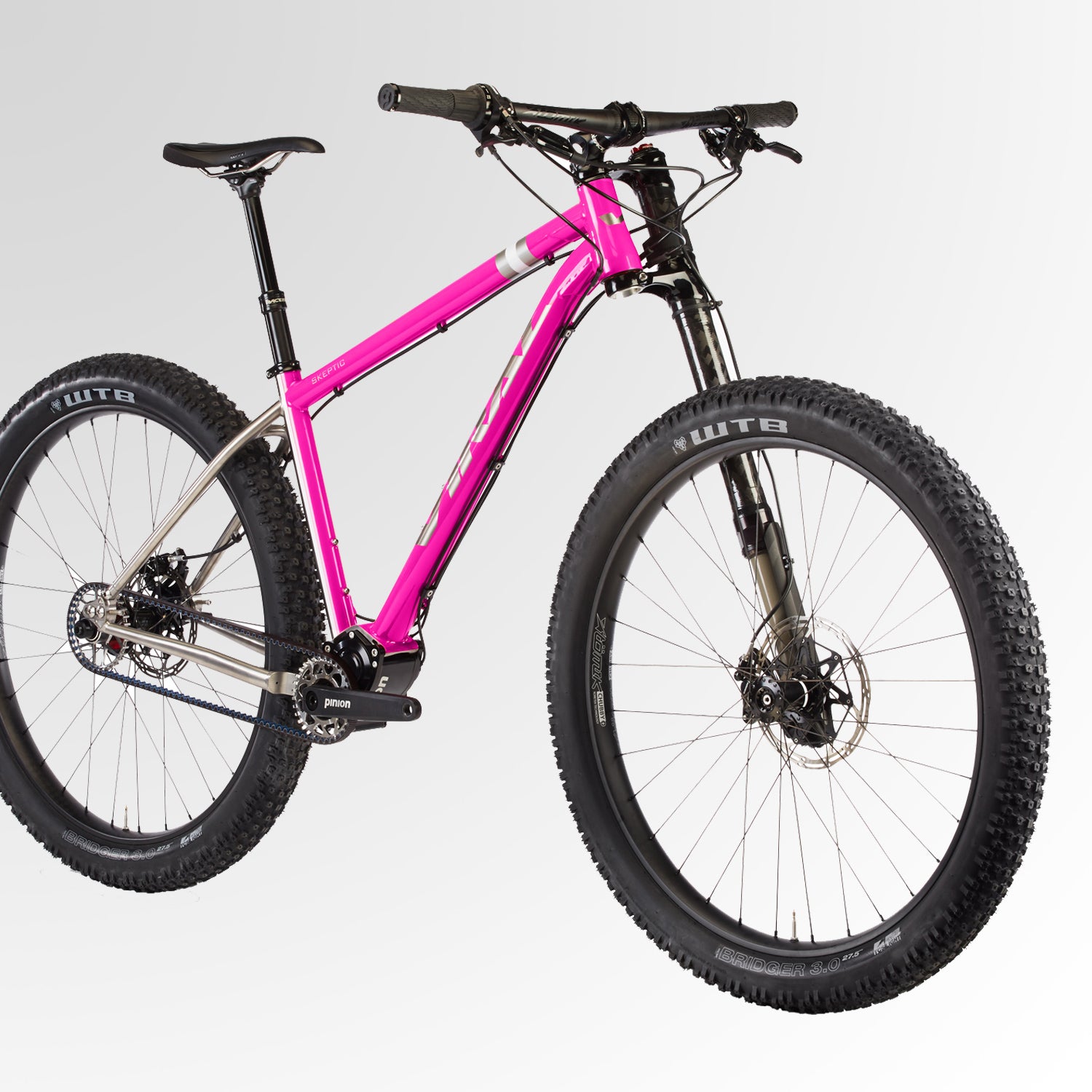Titanium hardtails might seem like an anachronism in this era of full-carbon, full-suspension, all-mountain machines. But the Viral Skeptic—with plus-size tires, belt drive, Pinion gearbox, and all-new kit from Race Face—is one of the most forward-looking bikes we’ve ridden in a while.
Viral Bikes is a new name for , the Denver, Colorado-based boutique brand launched two years ago by Niner-founder and longtime engineer Steve Domahidy. He’s been putting out a smattering of small-batch carbon and ti- bikes since he started, but recently decided to re-brand the company under the much catchier Viral moniker. The Skeptic is the new company’s first release. And it’s a doozy.
At the heart of the bike is the , a simple looking and largely obscure gearing system that lives at the bottom bracket rather than the rear hub (like most). Inside that weather-sealed, heart-shaped box is series of gears all stacked together that provide a whopping 600 percent of gear range. That’s more range than the new ultra-wide 1×12 system from SRAM and even the broadest 2×11 setup from Shimano. Pinion’s other big advantage is its simplicity, with a quiet and lube-free Gates Carbon Belt Drive providing the power and a required system oil change only every 6,000 miles. That means you get a huge gear set minus the complications of derailleurs in a largely maintenance-free system.
Unusual drivetrain apart, the Skeptic is a pleasantly slack (67.5-degree head angle) all-mountain hardtail built around 27.5+ wheels with three-inch tires. (The frame will fit 29ers, too.) Having ridden numerous plus-size hard tails, this one included, we’ve basically decided that these big tires will make the standard rigid rear-end bike obsolete, except for in the highest level cross-country racing. The extra rubber (chunky Schwalbe Rocket Rons in our case), irons out the harshness of the trail and also adds grip and confidence that is often lost in the rigid chatter.
Domahidy is selling the Skeptic as frame-only configuration (including frame, gearbox, belt drive and cogs, and shifter) for $5,000, which means that buyers will get to customize the build to their riding style. Other than the excellent, 130-millimeter Fox 34 fork, which provided just the right balance of weight and stiffness for the ride, our tester had some fascinating new tech. (According to Domahidy, the Cannondale Left Supermax fork that’s pictured weighs about the same as our Fox.) The (built around DT Swiss 350 hubs) employ a flashy looking spline design on the carbon rims that is said to add stiffness without weight, and the wheels indeed felt crisp and precise. The bring the company’s excellent Guide technology to a lighter, cross-country realm, and though they felt fine we’d probably have just preferred the extra power of the Guides. Best of all was the new , which has a large and comfy ergonomic lever, infinite height adjustment, and a silky smooth action. We also liked the new, tough Race Face Next 35 stem and handlebars, which use a larger diameter for added stiffness and strength.
All said, it’s a bling bike with lots going on that largely—but not wholly—lives up to its promise. On the big-chunk riding in Sedona, the Skeptic shredded hard enough to keep pace with full-suspension rigs, winning us over again to the benefits of the hardtail. There’s something visceral and super connected about no rear suspension, especially in titanium (and with plus-size wheels), where you get the amazing trail feel without all the brutal vibration. We chucked this bike down steep gullies, through ugly rock gardens, and over sheer ledges and never felt like we pushed the Skeptic beyond its comfort zone. It really is an all-mountain machine.
We loved the range of the Pinion gearbox, but it did have a few drawbacks. In order to shift, it’s necessary to pause pedaling for a second. That works fine while descending, where coasting is no issue, but it lead to some hesitation and stalling on climbs, especially steep, loose ones where momentum can be key. We’re sure that we’d improve and adjust as we learned the system, but it definitely proved halting to begin with.
The Pinion also adds more weight than most systems, with our bike tipping the scales at just over 30 pounds. That’s not terrible compared to other plus-size bikes: the majority we’ve been testing are in the 27- to 28-pound range. And the good news about the weight here is that it’s centered and low, so it doesn’t feel unwieldy in tech like, say, a Rohloff hub. That’s why the Skeptic performs so admirably in rough terrain, with the extra weight actually helping to blast the bike through the chunder. Still, many riders are (rightly, in our opinion) going to want a lighter machine at this steep price.
The steep cost is the Skeptic’s other drawback. Our rig would run you $8,500, and while that’s on a par with many bikes on the market these days, most of that competition is lighter and includes full suspension. What you get for that price, however, is a bike crafted with beautiful attention and some of the most interesting technology on the market right now.
It’s unclear to us whether or not the Pinion Gearbox is the future for mountain bikes: we like the idea and the simplicity, but the shift quality needs some honing. Still, the setup holds a lot of promise, and we like the ingenuity and effort to try something new. The same can be said for the Viral Skeptic in general, which is gorgeous, a hoot to ride, and blessedly different than pretty much every bike on the market.


